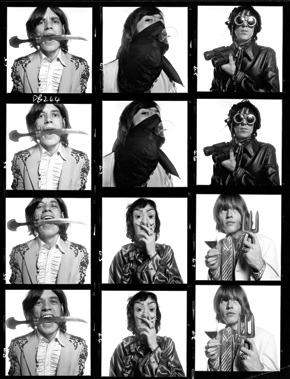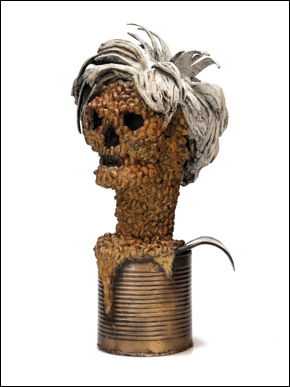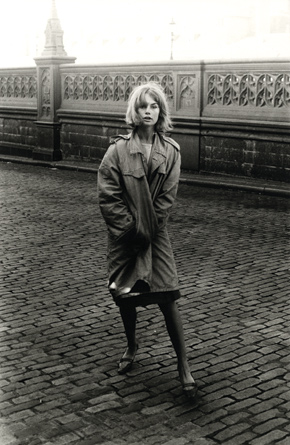
|
 |

 |
 |
 |
 |
 |
 |
 |
 |

|
 Bailey Blown up As suggested by the title of his recent Skull Beneath the Skin exhibition, Britain’s greatest photographer David Bailey exposes the interior landscape of his subjects’ lives. Christopher Kanal pays a visit to his London studio to find out what drives him. ‘I don’t expect to be understood,’ says David Bailey. ‘If you care what people think it’s difficult to get through the day.’ We are in the photographer’s studio in Clerkenwell tucked away on a cobbled mews. Bailey, and he is just called ‘Bailey’ by those around him, relaxes on a sofa, mug of coffee in hand, and talks about his latest exhibition, David Bailey: The Skull Beneath the Skin, which has just finished at the Pangolin Galley in London. One of Bailey’s sculptures, Dead Andy, was of old friend Andy Warhol. At his studio on Dartmoor, Bailey got a tin can, filled it with beans and then used some more beans to sculpt Warhol’s head. After covering it in plaster, he let it set overnight. The next morning he awoke to discover it had exploded. Beans everywhere. ‘It shot the whole lot out of the can,’ he roars. Bailey laughs a lot. It’s a miserable grey day outside, but Bailey is on top form, buzzing with energy, effusive and revealing. The 72-year-old’s Jack Russell, Pig, is inquisitively scampering around. Bailey sits on a sofa, bearded, wearing slacks, a colourful shirt and battered shoes. The studio is full of banter. Pig barks a lot but I do wonder whether she is laughing along with her owner. The two seem kindred spirits. We talk about last month’s Frieze Art Fair. ‘The best year I’ve seen in ages,’ says Bailey. I mention the work of a young American fashion photographer that was the talk of the fair. One of Bailey’s assistants, Mark, Googles him on his Mac. Images of lithe young nudes photographed in stylised poses in the wilderness appear. ‘Bailey, you’re going to love this one,’ says Mark, of a shot of an attractive, raven-haired model photographed in a forest. ‘These are bloody silly,’ says Bailey. ‘Do you not find them interesting? ‘“Interesting” is the worst word you can use about anything,’ says Bailey, playfully. ‘You can say “I fucking hate it”, “I fucking love it”, but “interesting” doesn’t go there. It just means you don’t know what you really like.’ Bailey may be a pensioner, but the photographer who made his name in the Swinging Sixties and was connected to some of the world’s most beautiful women, has still got ‘It’. The wild bright eyes and ranging intellect are as sharp as the silly jokes and pistol-quick wit. He’s a gas to be around and there seems to be no stopping him. Sculptures and skulls aside, it’s impossible to ignore Bailey’s stature as one of photography’s greats. You only have to look around. London crime lords Ronnie and Reggie Kray are eyeing me on the right from one of Bailey’s most iconic portraits. In a hidden corner tucked away on a ledge gathering dust are a small number of his many awards. An Emmy sits at the back. Bailey doesn’t do explanations of what he creates. When asked questions about the meaning behind his skulls, he swats them down with a swift response and a splash of wit topped off with an infectious cackle. Bailey is more interested in showing what Mark has just brought back for him from Rio.
‘This is my favourite thing at the moment,’ he says, holding a lime coloured wooden trinket. ‘This is the best piece of art I have recently acquired, better than most stuff in galleries.’ Beneath the surface ‘I’m not saying I’m a sculptor, I just make images. I don’t take photographs, I make them,’ he says. ‘And now I’m making something else.’ It was a successful exhibition and a number were sold. When Bailey sets his sights on something, expect sparks but don’t call him an artist. ‘I don’t know what the word artist means,’ he says. ‘It’s a bit like art and love, and I don’t get it. It’s so subjective. I mean – what is love and what is art? I think the definition I like is when somebody said to Count Basie: “What’s jazz?” and he said: “Four beats to the bar and no cheating.” I’m with Basie in that respect. There’s lots of bollocks in the art world.’ Among the many sculptures at Pangolin there was a miniature skull cast in silver. ‘The skull is nature’s sculpture,’ he says. But there is humour in his treatment of our primal instincts of hunger, fear and sex, and the onslaught of death. Bailey’s fascination with this form of sculpture mirrors his love of the tribal art, particularly African and Oceanic pieces, that he has been collecting for years. ‘I like it because it wasn’t done for artistic reasons,’ he explains. ‘It comes from within, from the spirit.’ Bailey likes to get inside skulls, into people and find out what makes them tick. It’s a highly personal talent that has resulted in some of the most defining images of the past 50-odd years – what he calls his ‘documents’ – from making Jean Shrimpton into a 1960s icon to capturing the impending tragedy of Brian Jones’s exile and death from the Rolling Stones, to covering the famine in Sudan for Band-Aid. For Bailey, photography is about the moment, the now. ‘It’s what happens,’ he explains. ‘You never know what is going to happen.’
The photographer has had a unique place in popular culture ever since Michelangelo Antonioni was inspired by Bailey’s lifestyle and work to make the 1966 film Blow-Up with David Hemmings and Vanessa Redgrave. ‘I know what I want,’ says Bailey, then serious. ‘Everything in my life is about common sense and simplicity. Less is more in everything, except sex.’ Start-up As an adolescent Bailey bunked school – in one year he only attended 33 times – bred parrots and went out exploring to fill his cabinets of curiosities. At 17, he saw a Picasso in Look magazine and was hooked. The painter’s simple, visual style seeped into him. Draughted to the Royal Air Force in 1957, Bailey did national service in Malaya. After his trumpet was stolen by ‘an officer and a gentleman’, as he describes him, he bought a Rolleiflex. Above his bunk Picasso’s portrait of Jacqueline Roque hung instead of a pin-up of Diana Dors. He never made it to art school. ‘Learning is for people who are not very intelligent – that’s why they have to go to university,’ he says. On return to London, he worked with David Ollins and John French. By 1961, at 23, he won a Vogue contract and his pictures rapidly gained cult status. It was a new world. ‘The 1960s were the first time the so-called working classes had a voice,’ he explains.
His first book, a collection of poster prints Box of Pin- Ups (1964) were striking photographs of 1960s celebrities and socialites, including Terence Stamp, The Beatles and the Kray twins, which caused considerable controversy at the time. As Bailey’s reputation grew his projects broadened – he did album sleeves for The Rolling Stones and Marianne Faithfull and moved into film-making, commercials and even started a magazine. After the 92-year-old late Irving Penn, he is the second-longest-serving photographer for Condé Nast. But it is photography for which he is best known, a passion that has led him to pursue ever more personal projects as he gets older, from the nudes of Bailey’s Democracy to The Lady is a Tramp: Portraits of Catherine Bailey, and Birth of the Cool 1957-1969. There is no Bailey style. ‘I don’t really like the idea of style,’ he says. ‘My eye hasn’t changed. It’s always been the same. It has always been simple and direct.’ With fame came sex, and Bailey’s way with women is legendary. Those he dated or married read like a roll of celluloid’s beautiful ones.
Recently, Annie Leibovitz assembled US Vogue’s photographers for an honorary portrait. Arranging her sitters, Leibovitz instructed Bailey to settle himself between the legs of the fashion editor and former model Grace Coddington. ‘Fuck me,’ extorted Bailey. ‘I’m back where I was 46 years ago.’ The room was silenced. Previously married to Rosemary Bramble, Catherine Deneuve and Marie Helvin, Bailey’s fourth wife is the gorgeous, vampish former model Catherine Dyer, who he married in 1986 when she was 22, and he was in his early 40s. They have three children: Paloma, 25, Fenton, 22 and Sascha, 16. ‘Stand up,’ Bailey says to me. I do, wondering where this is going. ‘See the big Damien butterfly?’ I look ahead to the large Hirst painting hanging on the bare brick wall at the other end of the studio. ‘Camera left and underneath,’ he instructs, leading my eyes to a new portrait of Kate Moss, one of Bailey’s many muses. The mixed media piece is going to feature in a new exhibition at Scream, Jamie and Tyrone Wood’s gallery. What is Kate Moss like I ask? frankness of the discussion, the most striking thing is how the pair are two of a kind.
Moss, however, is not the first woman to inspire Bailey. Is That So, Kid, recorded a year photographing the raven-haired goddess Anjelica Huston for Vogue. In 1973, Bailey and his young muse flew to Riviera beaches and art deco hotel rooms in a couture remake of Summer Holiday. Bailey’s life has been intertwined with the cultural zeitgeist of each decade. Bailey first met Huston at a party thrown by her father, the director John Huston, where he was accompanied by his then wife Catherine Deneuve, whom Roman Polanski had introduced him to, while Bailey had previously introduced Sharon Tate to Polanski. Of fame today, Bailey has little time. ‘Stupidity just has a bigger voice now that you have a celebrity culture,’ he says. ‘You have the money to air opinions and tastes. That is why it is so disastrous.’ The art of war Constant change is better than just constant, isn’t it?’ Earlier this year, Bailey was in Afghanistan shooting a book for the Help for Heroes charity, one of the many he is involved with. ‘I have two boys who are Army age and I thought, “I really don’t want these kids to die for a war I don’t agree with”,’ he explains. Bailey was in murderous Helmand province, but won’t call it war photography. ‘I wasn’t being shot at by snipers,’ he reflects. ‘I have been to worse places than that. Sudan was more emotional, with people dying in front of you.’ He candidly admits feeling very vulnerable flying in Chinooks travelling over Helmand, but enjoyed meeting the troops, drawing on his years in the RAF. There have been five exhibitions of his work this year and three are already planned for 2011. One of his major projects at the moment is David Bailey’s Delhi Dilemma, and this new series of photographs depicts the colours and characters of the Indian capital without cliché – a child walks down a rust coloured track. It is intimate and simple. Very Bailey. Bailey adores India. He’s been there at least 20 times. ‘The idea of having so many gods it’s impossible to count, I love it,’ he says. ‘There is such diversity and an accumulation of intelligence. One of his biggest collectors asked him to do a book on India. ‘I said: “I can’t, it will take me 5,000 years”,’ he laughs. ‘I can do a book on Delhi, Sikkim, Kerala. Try to do a book on India and it’s impossible. That is why I call it Bailey’s Delhi Dilemma. How do you photograph something that has been photographed to death?’ Bailey doesn’t travel as much as he used to and misses catching up with his good friends: ‘Jack [Nicholson], Julian [Schnabel] and Bruce [Weber].’ Bailey doesn’t do surnames. He mentions a ‘disastrous lunch at the Connaught with Jack’. I really want to know what happened and imagine Nicholson and Bailey out on the town, but Bailey is already off, way ahead on something else, and I’m swept along. I ask Bailey if there is anyone he wants to photograph. Sitting on a ledge just above Bailey’s head is a birthday card with the US President’s face on it. Obama perhaps?
‘Not particularly,’ he says. ‘My pictures are about talking to people. If anything is on his side he fucking looks like a film star. He came at the right time. He’s not too black, he’s not too white.’ We are running out of time and I’m given a reminder of Bailey’s iconic status. Copies of The British Heroes in Afghanistan arrive and are waiting to be signed by him. The key to being Bailey begins wit curiosity. ‘Everything excites me, from family snaps to paparazzi pictures,’ he reveals. ‘Everything is a source of interest and curiosity to me.’ Bailey has never lost his interest in people. He is notorious for talking to his subjects at length before a shoot – about their lives and who they are. That’s the way Bailey is and he keeps going. ‘Everything has got to keep moving,’ he says. ‘Otherwise there would be no curiosity. Curiosity makes the world go round.’ Perhaps Bailey’s instinct for engaging with the now can be found in the very first moment I met him. On arriving outside his studio, Bailey shouted down to me from the balcony: ‘How old are you?’ he asked, Pig yapping at his side. He told me that he had placed a bet with the rest of the studio on my age. Guess who was closest, out by just one year? |
 Commanding presence Commanding presenceCarlos Acosta challenges every traditional notion of the male ballet dancer. His athletic, striking masculinity and humility is a refreshing departure. He shares his memories as a young dancer in his native Cuba, and his hopes for the future, with Sasha Kanal. read article  Laughter in the dark Laughter in the darkThe artist David Shrigley is often imitated but never equalled. He talks to Ellie Broughton about his latest book, his relationship with collectors and the role of illustration in fine art. read article  Cultural
Mecca Cultural
MeccaAbu Dhabi is creating a $27 billion arts complex on Saadiyat Island with a little help from some of the world’s most renowned architects and cultural consultants. read article
|
 |
 |
 |
 |
 |
 |
 |
 |












